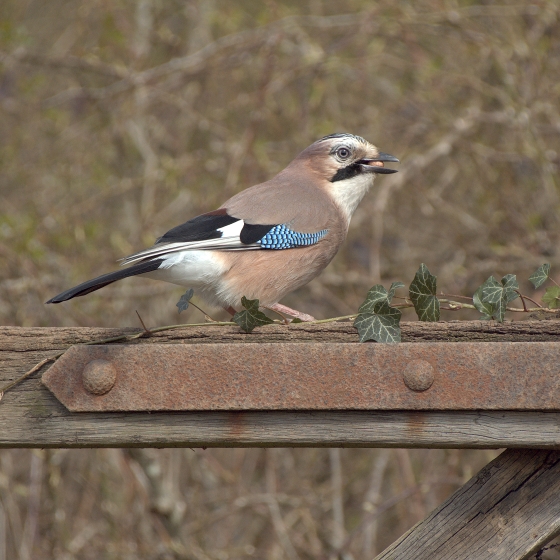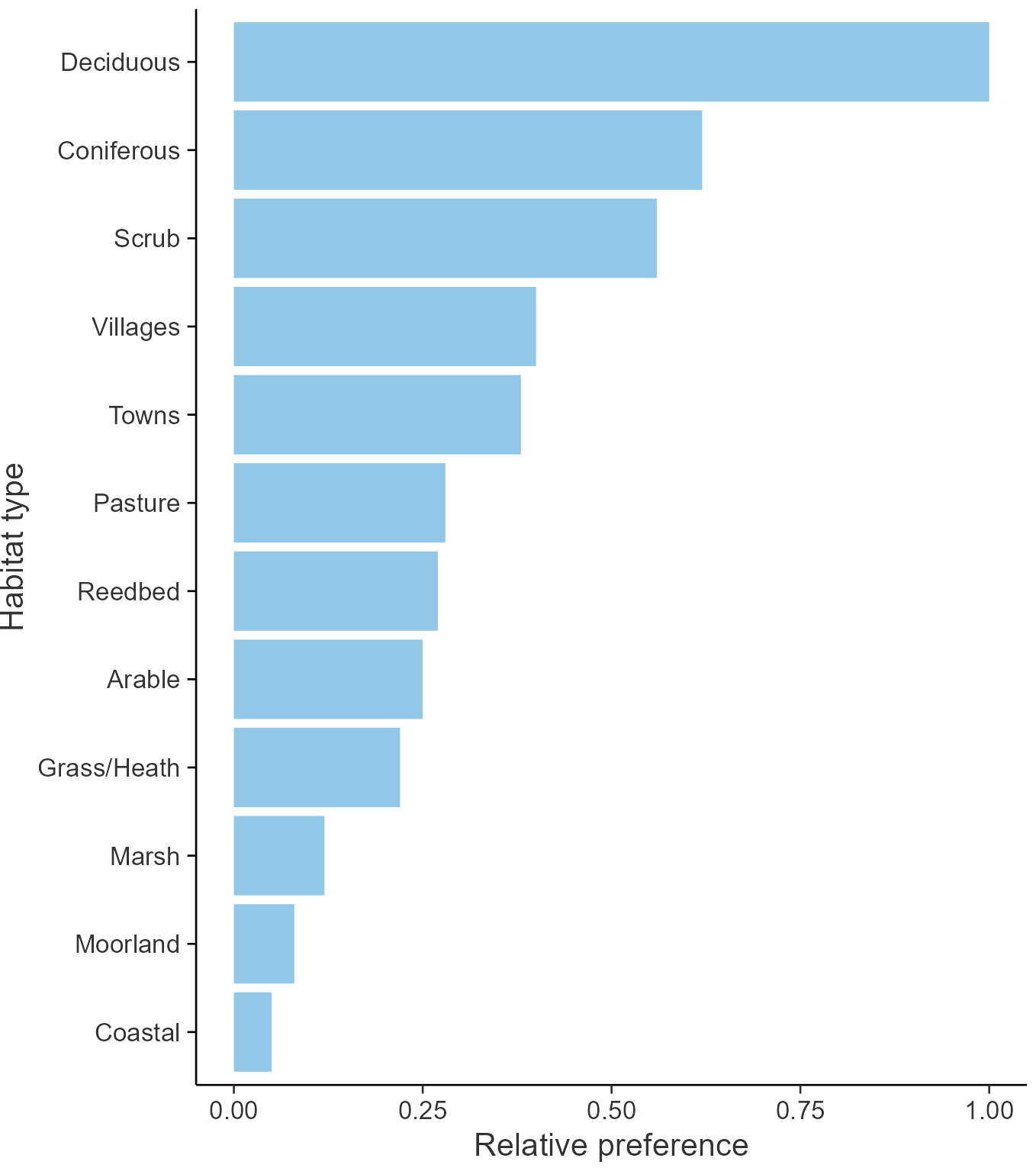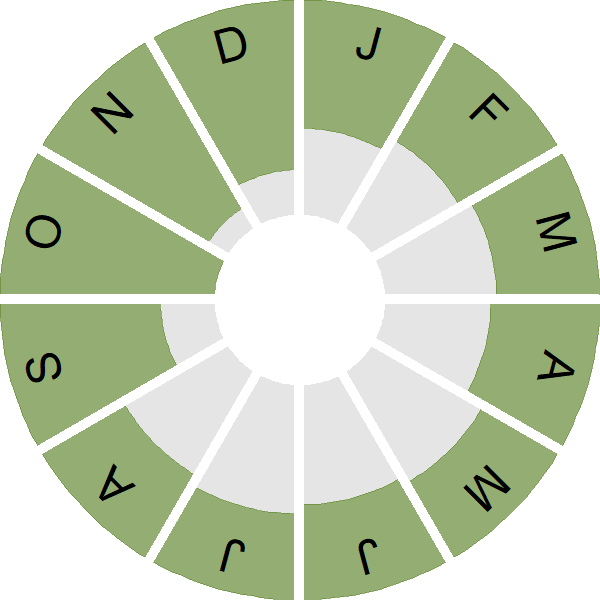Jay

Introduction
A very colourful member of the crow family, Jays are often mistaken for something more exotic from warmer climes.
The pinkish plumage and striking blue and black barring on the wing make the Jay stand out from its neighbours. It has a bounding flight where its white rump is an easily noticed feature. Landing in a tree, the bird swoops up to a branch and then sits tight making it surprisingly hard to see when perched. Its raspy call can be the best indicator of its presence.
The Bird Atlas 2007-11 suggests that Jay distribution is constrained by woodland cover and climate. Recent surveys have shown the range of this species to be expanding to the north and west, particularly in Scotland and Ireland, although the fluctuating population numbers show no real trend up or down.
- Our Trends Explorer gives you the latest insight into how this species' population is changing.

Key Stats
Identification
Songs and Calls
Song:
Call:
Alarm call:
Status and Trends
Conservation Status
Population Change
The UK Jay population remained stable in the species' preferred woodland habitat until the late 1980s, after which the population began to decline. This decrease followed an earlier decline on farmland CBC plots (Gregory & Marchant 1996). With the losses since the 1980s now regained, long-term trends are stable overall. The BBS map of change in relative density between 1994-96 and 2007-09 indicates that increases occurred almost everywhere during this period, with the exception of parts of central southern England. Mean brood size appears to have increased by half a chick since 1968, and nest success has also improved, so the number of fledglings per breeding attempt has increased, though all demographic measures are based on small samples. There has been an increase across Europe since 1980 (PECBMS: PECBMS 2020a>).
Distribution
Jay distribution within Britain & Ireland is thought to be constrained by woodland cover and climatic conditions.
Occupied 10-km squares in UK
or view it on Bird Atlas Mapstore.
or view it on Bird Atlas Mapstore.
European Distribution Map
Distribution Change
Jay's winter distribution has expanded since the 1981–84 Winter Atlas, with an 86% range expansion in Ireland and a 16% expansion in Britain, where there have been major gains in Scotland.
Change in occupied 10-km squares in the UK
or view it on Bird Atlas Mapstore.
or view it on Bird Atlas Mapstore.
Seasonality
Jay is recorded throughout the year but detections peak in autumn when birds disperse or are actively seen caching food for the winter.
Weekly pattern of occurrence
The graph shows when the species is present in the UK, with taller bars indicating a higher likelihood of encountering the species in appropriate regions and habitats.

Habitats
Breeding season habitats
Relative frequency by habitat
The graph shows the habitats occupied in the breeding season, with the most utilised habitats shown at the top. Bars of similar size indicate the species is equally likely to be recorded in those habitats.

Movement
Britain & Ireland movement
Foreign locations of birds ringed or recovered in Britain & Ireland
Dots show the foreign destinations of birds ringed in Britain & Ireland, and the origins of birds ringed overseas that were subsequently recaptured, resighted or found dead in Britain & Ireland. Dot colours indicate the time of year that the species was present at the location.
- Winter (Nov-Feb)
- Spring (Mar-Apr)
- Summer (May-Jul)
- Autumn (Aug-Oct)

European movements
EuroBirdPortal uses birdwatcher's records, such as those logged in BirdTrack to map the flows of birds as they arrive and depart Europe. See maps for this species here.
The Eurasian-African Migration Atlas shows movements of individual birds ringed or recovered in Europe. See maps for this species here.
Biology
Productivity and Nesting
Nesting timing
Egg measurements
Clutch Size
Incubation
Fledging
Survival and Longevity
Survival is shown as the proportion of birds surviving from one year to the next and is derived from bird ringing data. It can also be used to estimate how long birds typically live.
View number ringed each year in the Online Ringing Report.
lifespan
Survival of adults
Survival of juveniles
Biometrics
Wing length and body weights are from live birds (source).
Wing length
Body weight
Ring Size
Classification, names and codes
Classification and Codes
- Order: Passeriformes
- Family: Corvidae
- Scientific name: Garrulus glandarius
- Authority: Linnaeus, 1758
- BTO 2-letter code: J.
- BTO 5-letter code: JAY..
- Euring code number: 15390
Alternate species names
- Catalan: gaig eurasiàtic
- Czech: sojka obecná
- Danish: Skovskade
- Dutch: Gaai
- Estonian: pasknäär
- Finnish: närhi
- French: Geai des chênes
- Gaelic: Sgreuchag-choille
- German: Eichelhäher
- Hungarian: szajkó
- Icelandic: Skrækskaði
- Irish: Scréachóg
- Italian: Ghiandaia
- Latvian: silis, krekis
- Lithuanian: eurazinis kekštas
- Norwegian: Nøtteskrike
- Polish: sójka (zwyczajna)
- Portuguese: gaio
- Slovak: sojka obycajná
- Slovenian: šoja
- Spanish: Arrendajo euroasiático
- Swedish: nötskrika
- Welsh: Sgrech y Coed
- English folkname(s): Acorn Jay
Research
Causes of Change and Solutions
Causes of change
There is little good evidence available regarding the drivers of the breeding population change in this species in the UK.
Further information on causes of change
No further information is available.
Information about conservation actions
The UK population of the Jay has been stable over the long-term and has increased over the last 25 years, hence it is not a species of concern and no conservation actions are currently required.
The drivers of change are not known and no specific conservation actions have been proposed for this species, although actions to maintain and restore woodland habitats to benefit declining woodland specialists may also benefit generalists including the Jay.
Publications (1)
Incorporating fine-scale environmental heterogeneity into broad-extent models
Author: Graham, L.J., Spake, R., Gillings, S., Watts, K. & Eigenbrod, F.
Published: 2019
08.04.19
Papers

